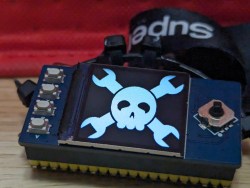“Emergency Law Enforcement Officer Hologram program activated. Please state the nature of your criminal or civil emergency.” Taking a cue from Star Trek: Voyager, the Seoul Metropolitan Police Agency is testing a holographic police officer, with surprisingly — dare we say, suspiciously? — positive results. The virtual officer makes an appearance every two minutes in the evening hours in a public park, presumably one with a history of criminal activity. The projection is accompanied by a stern warning that the area is being monitored with cameras, and that should anything untoward transpire, meat-based officers, presumably wearing something other than the dapper but impractical full-dress uniform the hologram sports, will be dispatched to deal with the issue.
Hackaday Columns4588 Articles
This excellent content from the Hackaday writing crew highlights recurring topics and popular series like Linux-Fu, 3D-Printering, Hackaday Links, This Week in Security, Inputs of Interest, Profiles in Science, Retrotechtacular, Ask Hackaday, Teardowns, Reviews, and many more.
Who Is Your Audience?
Here at Hackaday HQ, we all have opinions about the way we like to do things. And no surprise, this extends to the way we like to lay out circuits in schematics. So when we were discussing our own takes on this piece on suggested schematic standards, it was maybe more surprising how much we did agree on than how much we had different preferred styles. But of course, it was the points where we disagreed that provoked the most interesting discussion, and that’s when I had a revelation.
Besides torturing electronics, we all also write for you all, and one thing we always have in mind is who we’re writing for. The Hackaday audience, not to blow you up, is pretty knowledgeable and basically “full-stack” in terms of the hardware/software spectrum. This isn’t to say that everyone is a specialist in everything, though, and we also have certain archetypes in mind: the software type who is just starting out with hardware, the hardware type who isn’t as savvy about software, etc. So, back to schematic layout: Who is your audience? It matters.
 For instance, do you organize the pinout for an IC by pin number or by pin function, grouping the power pins and the ADC pins and so on? If your audience is trying to figure out the circuit logic, you should probably go functional. But if you are trying to debug a circuit, you’re often looking at the circuit diagram to figure out what a given pin does, and the pin-number layout is more appropriate.
For instance, do you organize the pinout for an IC by pin number or by pin function, grouping the power pins and the ADC pins and so on? If your audience is trying to figure out the circuit logic, you should probably go functional. But if you are trying to debug a circuit, you’re often looking at the circuit diagram to figure out what a given pin does, and the pin-number layout is more appropriate.
Do you lay out the logical flow of the circuit in the schematic, or do you try to mimic the PCB layout? Again, it could depend on how your audience will be using it. If they have access to your CAD tool, and can hop back and forth seamlessly from schematic to PCB, the logical flow layout is the win. However, if they are an audience of beginners, or stuck with a PDF of the schematic, or trying to debug a non-working board, perhaps the physical layout is the right approach.
Al Williams, who has experience with projects of a much larger scale than most of us self-taught hackers, doesn’t even think that a schematic makes sense. He thinks that it’s much easier to read and write the design in a hardware description language like VHDL. Of course, that’s certainly true for IC designs, and probably also for boards of a certain complexity. But this is only true when your audience is also familiar with the HDL in question. Otherwise, you’re writing in Finnish for an audience of Spaniards.
Before this conversation, I was thinking of schematic layout as Tom Nardi described it on the podcast – a step along the way to get to the fun parts of PCB layout and then to getting the boards in hand. But at least in our open-source hardware world, it’s also a piece of the documentation, and a document that has an audience of peers who it pays to keep in mind just as much as when I’m sitting down and writing this very newsletter. In some ways, it’s the same thing.
(And yeah, I know the featured image doesn’t exactly fit the topic, but I love it anyway.)
Hackaday Podcast Episode 334: Radioactive Shrimp Clocks, Funky Filaments, Owning The Hardware
In this episode of the Hackaday Podcast, editors Elliot Williams and Tom Nardi start out with a warning about potentially radioactive shrimp entering the American food supply via Walmart, and things only get weirder from there. The extra spicy shrimp discussion makes a perfect segue into an overview of a pair of atomic One Hertz Challenge entries, after which they’ll go over the latest generation of 3D printer filament, using an old Android smartphone as a low-power Linux server, some tips for creating better schematics, and Lorde’s specification-bending transparent CD. Finally, you’ll hear about how the nature of digital ownership influences the hardware we use, and on the other side of the coin, how open source firmware like QMK lets you build input devices on your terms.
Check out the links below if you want to follow along, and as always, tell us what you think about this episode in the comments!
This Week In Security: Anime Catgirls, Illegal AdBlock, And Disputed Research
You may have noticed the Anime Catgirls when trying to get to the Linux Kernel’s mailing list, or one of any number of other sites associated with Open Source projects. [Tavis Ormandy] had this question, too, and even wrote about it. So, what’s the deal with the catgirls?
The project is Anubis, a “Web AI Firewall Utility”. The intent is to block AI scrapers, as Anubis “weighs the soul” of incoming connections, and blocks the bots you don’t want. Anubis uses the user agent string and other indicators to determine what an incoming connection is. But the most obvious check is the in-browser hashing. Anubis puts a challenge string in the HTTP response header, and JavaScript running in the browser calculates a second string to append this challenge. The goal is to set the first few bytes of the SHA-256 hash of this combined string to 0.
[Tavis] makes a compelling case that this hashing is security theatre — It makes things appear more secure, but doesn’t actually improve the situation. It’s only fair to point out that his observation comes from annoyance, as his preferred method of accessing the Linux kernel git repository and mailing list are now blocked by Anubis. But the economics of compute costs clearly demonstrate that this SHA-256 hashing approach will only be effective so long as AI companies don’t add the 25 lines of C it took him to calculate the challenge. The Anubis hashing challenge is literally security by obscurity.
Continue reading “This Week In Security: Anime Catgirls, Illegal AdBlock, And Disputed Research”
Linux Fu: Windows Virtualization The Hard(ware) Way
As much as I love Linux, there are always one or two apps that I simply have to run under Windows for whatever reason. Sure, you can use wine, Crossover Office, or run Windows in a virtual machine, but it’s clunky, and I’m always fiddling with it to get it working right. But I recently came across something that — when used improperly — makes life pretty easy. Instead of virtualizing Windows or emulating it, I threw hardware at it, and it works surprisingly well.
Once Upon a Time
First, a story. Someone gave me a Surface Laptop 2 that was apparently dead. It wouldn’t charge, and you can’t remove the keyboard without power. Actually, you can with a paper clip, and I suggested pulling it to see if the screen would charge by itself. They said they had already bought a new computer, so they didn’t care.
Unsurprisingly, once I popped the keyboard off, the computer charged and was fine. You just have to replace the keyboard or use another one. Or use it as a tablet, which it is set up for anyway. But I have plenty of laptops and computers of every description. What was I going to do with this nice but keyboardless computer? Continue reading “Linux Fu: Windows Virtualization The Hard(ware) Way”
FLOSS Weekly Episode 843: Money Usually Helps
This week Jonathan and Dan chat with Farid Abdelnour about Kdenlive! It’s top quality video editing software, and happens to be what we use to edit the show! What’s next for the project, and how can you help? Watch to find out!
Continue reading “FLOSS Weekly Episode 843: Money Usually Helps”
Instant Macropad: Just Add QMK
I recently picked up one of those cheap macropads (and wrote about it, of course). It is surprisingly handy and quite inexpensive. But I felt bad about buying it. Something like that should be easy to build yourself. People build keyboards all the time now, and with a small number of keys, you don’t even have to scan a matrix. Just use an I/O pin per switch.
The macropad had some wacky software on it that, luckily, people have replaced with open-source alternatives. But if I were going to roll my own, it would be smart to use something like QMK, just like a big keyboard. But that made me wonder, how much trouble it would be to set up QMK for a simple project. Spoiler: It was pretty easy.
The Hardware

Since I just wanted to experiment, I was tempted to jam some switches in a breadboard along with a Raspberry Pi Pico. But then I remembered the “simple badge” project I had up on a nearby shelf. It is simplicity itself: an RP2040-Plus (you could just use a regular Pi Pico) and a small add-on board with a switch “joystick,” four buttons, and a small display. You don’t really need the Plus for this project since, unlike the badge, it doesn’t need a battery. The USB cable will power the device and carry keyboard (or even mouse) commands back to the computer.
Practical? No. But it would be easy enough to wire up any kind of switches you like. I didn’t use the display, so there would be no reason to wire one up if you were trying to make a useful copy of this project.


















